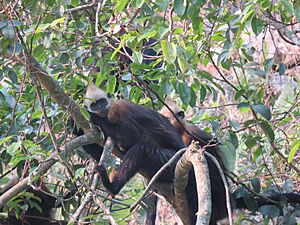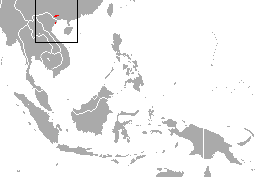Cat Ba langur facts for kids
Quick facts for kids Cat Ba langur |
|
|---|---|
 |
|
| Cat Ba langurs at Cát Bà National Park, Vietnam | |
| Conservation status | |
| Scientific classification | |
| Genus: |
Trachypithecus
|
| Species: |
poliocephalus
|
 |
|
| Cat Ba langur range (includes range of white-headed langur) | |
The Cat Ba langur (Trachypithecus poliocephalus) is also known as the golden-headed langur. It is a very rare type of langur found only on Cát Bà Island in Vietnam. This special monkey is one of the rarest primates in the world. It might even be the rarest primate in all of Asia. Scientists believe there are fewer than 70 of these langurs left. This makes them critically endangered.
Contents
What is a Cat Ba Langur?
The Cat Ba langur is a type of monkey. It is part of a group called Trachypithecus. These langurs are mostly black. Their head, cheeks, and neck are a bright golden or yellowish-white color. This is why they are sometimes called "golden-headed langurs."
Appearance
Cat Ba langurs have black skin. Their fur is dark brown. But their head and shoulders are a bright golden or yellowish-white. They have a very long tail, about 85 centimeters (33 inches) long. Their body is about 50 centimeters (20 inches) long.
Baby langurs are born with bright golden-orange fur. This color starts to change around four months old. Male and female langurs look very similar. Adult females weigh a little over 9 kilograms (20 pounds).
Daily Life
Cat Ba langurs are active during the day. They live in groups of about four to eighteen animals. They spend most of their time resting. The rest of their time is spent moving, looking for food, and playing. They rest more in winter and are more active in summer.
Where Do They Live?
The Cat Ba langur lives on Cat Ba Island in Vietnam. This island is the biggest in a group of 366 smaller islands. These islands are known for their unique karst landscape. This means the land is made of limestone that has been worn away by water. This creates tall ridges, towers, and caves.
Their Home
Cat Ba langurs love the steep limestone cliffs. Most places where they live are hard for humans to reach. They use caves, ledges, and overhangs to sleep. These spots protect them from bad weather and predators.
The island has a moist tropical rainforest. In summer, it is warm and rainy. Temperatures are around 25°C (77°F). In winter, it is cooler with less rain. Temperatures are usually below 20°C (68°F).
Water and Food
There are no permanent rivers or streams on Cat Ba Island. The langurs get their water from rainwater. They drink water caught in rock pockets. They also get moisture from the plants they eat.
The soil on the island comes from the limestone rocks. It also has dead leaves and plants. This helps the plants grow that the langurs eat.
Family Life
Cat Ba langurs live in groups. Usually, one male lives with several females and their babies. Each group has its own area. The adult male protects this area. He also decides where the group will go.
Females usually have one baby every two to three years. The babies become adults when they are four to six years old. Langurs can live for about 25 years.
What They Eat
Cat Ba langurs are mostly plant-eaters. Their diet is called "folivorous." This means they mainly eat leaves. Leaves make up over 70% of their food. They also eat fresh shoots, flowers, bark, and some fruits.
Why Are They Endangered?
The Cat Ba langur is one of "The World's 25 Most Endangered Primates." Their numbers have dropped by 80% in the last three generations. There are fewer than 70 of these langurs left.
Past Dangers
In the past, hunting was a big problem for Cat Ba langurs. People hunted them for traditional medicine. A "monkey balm" was made from them. This balm was believed to help with health issues.
Hunting was very hard because there were so few langurs. Hunters might spend weeks looking for one. But a single langur could bring a lot of money. This made hunting a risk worth taking for some.
New Challenges
Cat Ba Island is becoming a popular place for tourists. New hotels and roads are being built. A new road runs near the park's edge. This might make it easier for hunters to reach the langurs' home.
How Are We Helping?
Many people are working to save the Cat Ba langur. In 2000, the Münster Zoo and the Zoological Society for the Conservation of Species and Populations started the Cat Ba Langur Conservation Project.
Protection Efforts
Cat Ba Island was made a National Park in 1986. But this did not stop hunting right away. In 2006, the National Park was made bigger. It now includes all the places where Cat Ba langurs live. Special Protection Zones were also set up. These zones offer the strongest protection under Vietnamese law.
There is a very special protected area on the eastern coast of Cat Ba Island. About 40% of the langur population lives here. This area has clear boundaries with buoys and signs.
Rangers and Community Help
The number of rangers in the area has increased. Local people, especially fishermen, have been told about the langurs' importance. Rangers can remove people and take away hunting tools they find. All known caves and hunter trails are now watched and controlled.
These efforts have made a big difference. By the end of 2001, hunting of the Cat Ba Langur had stopped. Since the project began, nine langurs have been born. Only three have died from natural causes.
Scientists hope that the Cat Ba langur population will grow. This will happen if their limestone homes are protected. There are also three Cat Ba Langurs at the Endangered Primate Center in Cúc Phương National Park in Vietnam.
Images for kids
-
Cat Ba langur range (includes range of white-headed langur)




